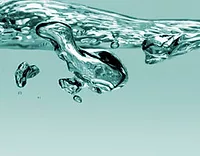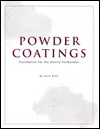Waterborne Polyurethane Resins for Glass Coatings
 Courtesy of Bayer Corp.
Courtesy of Bayer Corp.Background
The new waterborne glass coating is a one-component system based on a water-reducible blocked polyisocyanate and a hydroxy-functional polyurethane dispersion.1 This section briefly describes the resin preparation and the chemical reactions between the blocked polyisocyanate and the hydroxy-functional polyurethane dispersion.Figure 1 shows a general reaction path for producing both components of this new waterborne glass coating.
 Courtesy of Bayer Corp.
Courtesy of Bayer Corp.As shown in Figure 1, the hydroxy-functional polyurethane dispersion is prepared in a slightly different manner. First, reacting a diisocyanate monomer with an OH-functional compound (i.e., polyester, polyether, polycarbonate) forms the polyurethane prepolymer. The prepolymer is then hydrophilically modified, followed by chain extension, introduction of the OH groups, and dispersion in water.6
 Courtesy of Bayer Corp.
Courtesy of Bayer Corp. Courtesy of Bayer Corp.
Courtesy of Bayer Corp.Experimental - Selection of Diisocyanate Monomer
Either H12MDI or IPDI were selected as the monomeric building block for the OH-functional polyurethane dispersion and the water-dispersible blocked poyisocyanate. A basic comparison of these cycloaliphatic monomers is given in Table 1.From earlier studies,9-11 it has been shown that H12MDI provides added protection against chemical agents, hydrolysis and abrasion compared to IPDI. The use of H12MDI as a building block has also been shown to improve the mechanical properties of coatings by providing a very ordered structure to the polymer backbone. All of these attributes are important for a glass coating. To confirm that H12MDI is the monomer of choice for the coating system, various tests were conducted. These tests and the results are given in the next section.
 Courtesy of Bayer Corp.
Courtesy of Bayer Corp.Resin Specification
The development of a glass coating began by preparing resins according to the specifications in Table 2.Formulation and Application
Films were prepared by adding the two resins at an NCO:OH ratio of 1:1. To study the effect of the monomer on the final film properties, two waterborne coating systems were evaluated and have been given the following designation: W and I based upon Table 2 (isocyanate/polyol). These systems are based solely on polymers of H12MDI (W) and IPDI (I), respectively. For each coating formulation, 0.2% Silquest A 189 (OSi Specialties) and 0.2% Dynasylan AMEO (Hüls) adhesion promoters were added. Dipropylene glycol was added at 1.6% to ensure optimum appearance of the film. The coatings were cured for 30 minutes at 160ºC. It should be noted that these coatings can be either spray or dip applied.Coatings based solely on H12MDI (W) were then tested for pendulum hardness, yellowing, water resistance and NaOH resistance. These coatings were baked at temperatures ranging from 140–220ºC for 10, 20 and 30 minutes, respectively, to determine the optimal curing schedule.
Benchmark
When working with waterborne coatings, a key question is whether the proven performance of current two-component solventborne systems can be achieved or exceeded. An aliphatic polyurethane solventborne system based on HDI-based trimer and a blend of hydroxy-functional polyesters was used throughout this study as a comparison. This system is designated 2K-PUR and contains the same silane adhesion promoters as the waterborne system. Courtesy of Bayer Corp.
Courtesy of Bayer Corp.Results and Discussion - Film Hardness
Normally, when curing methyl ethyl ketoxime blocked polyisocyanates, a bake of 140ºC for 30 minutes is required to unblock the polyisocyanate and allow cure. The effect of baking temperature vs. baking time was examined to determine when each system reached its maximum pendulum hardness. The results are shown in Figure 4.These results indicate that the system based on H12MDI (W) reaches a maximum pendulum hardness at a lower temperature than the blocked IPDI (I) coating. This is consistent with what was reported in the literature for H12MDI blocked polyisocyanates.11,12 Moreover, the pendulum hardness increases as the baking temperature increases.
 Courtesy of Bayer Corp.
Courtesy of Bayer Corp.Pendulum hardness tests were performed on the H12MDI (W) based coatings to determine the temperature/baking time relationship for this system. These results are shown in Figure 5.
From this figure, it can be concluded that a maximum pendulum hardness of approximately 160 seconds can be reached by baking the H12MDI-based system at higher temperatures or longer periods of time. This system reaches a maximum pendulum hardness of approximately 160 seconds after baking the coated glass panels according to one of the following baking schedules: 10 minutes at 190ºC, 20 minutes at 170ºC or 30 minutes at 160ºC. Therefore, one can choose the necessary curing schedule for the H12MDI (W) system by adjusting the baking time or temperature.
 Courtesy of Bayer Corp.
Courtesy of Bayer Corp.Abrasion Resistance
In addition to the hardness of the films, the abrasion resistance of each system was evaluated. Results from the Taber abrasion test are given in Figure 6 for films cured at 160ºC for 30 minutes.The system, based upon H12MDI showed improved abrasion resistance compared to both the IPDI and the solventborne 2K PUR coating formulated for this study. This attribute is essential for the development of a glass coating system.
 Courtesy of Bayer Corp.
Courtesy of Bayer Corp.Water Resistance
To test the effect of water on the cured films and to compare adhesion loss, coated glass panels were placed in a heated water bath (40ºC) for 10 days. After 10 days, the 2K-PUR system exhibited slight micro-bubble formation that was not evident on the waterborne films. The IPDI based system (I) showed a decrease in hardness and higher sensitivity to scratching that was not observed with the W system. These results support the claim that the structure of H12MDI provides added protection of a coating system to hydrolysis.9,11These test results also correlate with the results obtained after exposing the W coated panels to 100 cycles in a typical household dishwasher. After this testing, the coated panels showed no signs of degradation. This again points to the fact that polyurethane resins based on H12MDI are suited for coating glass to meet the harsh demands of the industry.
In addition, a baking temperature/time study was performed to determine the optimal cure schedule for the water resistance of the W system. The coated glass panels were baked at temperatures ranging from 140–220ºC for 10, 20 and 30 minutes, respectively. The panels were then immersed in water at 40ºC for seven and 14 days. The crosshatch adhesion test was then performed on the coating, and the results were reported in terms of percent adhesion loss. The results of this test are shown in Table 3.
Data in the table indicate that after 14 days of water immersion at 40ºC, 0% adhesion loss can be achieved if the system is baked for 20 or 30 minutes at 160ºC. Also, the seven-day immersion data indicate that excellent adhesion is achieved by baking the system at 180ºC for 10 minutes, or 160ºC for 20 or 30 minutes, respectively.
NaOH Resistance
Since many glass objects must be sterilized before use, a glass coating must be highly resistant to caustic solutions. To determine the sodium hydroxide resistance of the new system, the W-based coated panels were baked at temperatures ranging from 140–220ºC for 10, 20 and 30 minutes, respectively. The panels were then immersed in a NaOH bath (5%) at 70ºC for four and 24 hours. The coatings were then evaluated for crosshatch adhesion. The test results are shown in Table 4.The data in the table indicate that after four hours of exposure to 5% NaOH solution at 70ºC, the W system attained 0% adhesion loss after baking at 180ºC for 20 or 30 minutes, or 190ºC for 10 minutes, respectively.
In addition, when immersing the W-based system in the NaOH solution for 24 hours, 0% adhesion loss can be achieved by using one of the following baking schedules: 30 minutes at 180ºC, 20 minutes at 190ºC, or 10 minutes at 210ºC, respectively.
 Courtesy of Bayer Corp.
Courtesy of Bayer Corp.Yellowing in Relationship to the Baking Schedule
One of the main objectives was to determine the yellowing/baking temperature relationship of the W system. Figure 7 shows the time/temperature relationship of this system.Yellowing of the coating is directly correlated to both baking time and temperature. The longer the exposure time and higher the temperature, the more severe the yellowing. Yellowing is minimal when using baking temperatures lower than 180ºC, corresponding to delta b values of 2 or less from the spectrophotometer measurements.
Summary
Waterborne polyurethane coatings are gaining increasing acceptance into the market due to the environmental advantages they offer and the high performance level they can achieve. This technology can also provide the glass and coatings industry with a high-performance polyurethane coating. Through the use of H12MDI as the building block, this high-performance glass coating exhibits excellent adhesion, abrasion resistance, and water and sodium hydroxide resistance. In addition, the coating performance is highly dependent on the baking schedule.Acknowledgements
The authors would like to thank Charles D. Taylor and Mary Crisci for their assistance in laboratory work.This paper was presented at the International Waterborne, High-Solids and Powder Coatings Symposium, March 1-3, 2000, in New Orleans.
For more information on resins, contact Ligia Martin, Randy Dearth, Dr. Sharon Feng, Bayer Corp., Coatings and Colorants Div., 100 Bayer Road, Pittsburgh, PA 15205-9741; or Dr. Beate Baumbach, Angela Kerznar, Bayer AG, D-51368 Leverkusen, Germany.
Looking for a reprint of this article?
From high-res PDFs to custom plaques, order your copy today!






